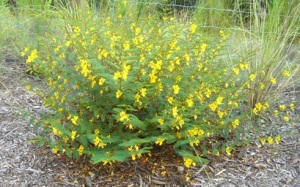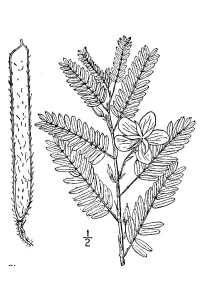

USDA-NRCS PLANTS Database / Britton, N.L., and A. Brown. 1913. An illustrated flora of the northern United States, Canada and the British Possessions. 3 vols. Charles Scribner’s Sons, New York. Vol. 2: 337.
Where Commonly Found: Open woods, plains, meadows, pastures, CT, MA, NY, RI.
How to Identify:
(For unfamiliar words: Wikipedia Glossary of Botanical Terms).
Go Botany Key to Chamaecrista fasciculata.
Missouri Botanical Garden description of Chamaecrista fasciculata. Click on more images.
Flower Color: Yellow.
Flower Type: Bilateral, large, showy, flowers, 1″- 1-1/2″ across, 10 stamen (6 red and 4 yellow), bloom from upper leaf axils in short cluster of 2-6 flowers. Petals are broad, a little unequal in size, can be red-streaked at base.
Flower Time: June to September.
Leaf Arrangement: Alternate leaves long flowering season. Shorter plants will stand erect while larger ones tend to sprawl. Slightly hairy stems.
Leaf Type: Pinnately compound leaves with many small, 10-36 narrow, yellow green entire leaflets, sensitive (folding) when touched.
Height: 1′-3′
Seed Collection: As soon as 1″-3″ narrow pod, turns color, harvest mature dark brown seeds by crushing or splitting the pods. Store cool, dry.
Attracts: Bees, Butterflies, Birds, Ants
Use: Tall Ground Cover for Pollinator Garden
Light: Full Sun to Part Sun
Hardiness Zone: 3 to 9 USDA Zone Map
Soils: Dry to Moist
Notes: Partridge Pea is a long-flowering ANNUAL, spreading wildflower excellent as a tall ground cover for a pollinator garden.
Introduced to NH, ME, native to Southern New England, NY, South and Midwest US: Biota of North America Program (BONAP) – North American Plant Atlas (NAPA).
You must be logged in to post a comment.